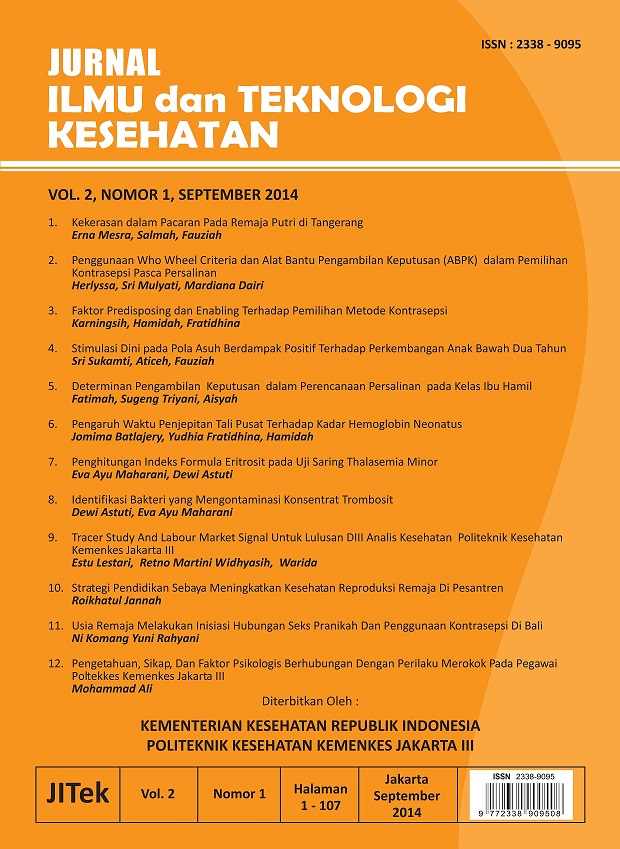Main Article Content
Abstract
Public demands into a high quality of health examination with right, accurate and appropriate are increased. Hence, it is responsibility of health professional to provide better service. However, the number of health analyst workers called laboratorian have various diverse of educational background. In respon to providing high quality analysts, Polytechnic of Health Ministry of Health Jakarta III intends to identify its graduation who work in health services in Jakarta and surrounding areas. This study aims to evaluate the progress of Program D III at Health Analyst department as well as its development; to assess the need of user about health analysts education level; and to improve the performance of Health Analyst department. The study is designed as cross-sectional with the use of descriptive research / survey type. The target of population were the entire graduated of Health Analyst department. Data collection was conducted in the area of Jakarta, Bogor, Depok, Tangerang and Bekasi (Jabodetabek) among alumni who work in hospital laboratories and 9 (nine) Clinics and Health Centers. Total number samples participated is 94 alumni. All data collected then was analyzed using SPSS. Learning experience in laboratory is the most important for alumni competence in the workplace, followed by learning experience in a community and hospital internships. It means there is association between education and the job attained. Professional certification is more important than academic achievement (IP), and participant expecting DIII program development into Bachelor level. " Tracer Study and labor Market Signal " encourage Health Analyst DIII Programme to improve Teaching Learning Process according to stakeholders needs
Keywords
Article Details
Authors who publish with this journal agree to the following terms:
1. Authors retain copyright and grant the journal right of first publication with the work simultaneously licensed under a Creative Commons Attribution-ShareAlike License that allows others to share the work with an acknowledgment of the work's authorship and initial publication in this journal.
2. Authors are able to enter into separate, additional contractual arrangements for the non-exclusive distribution of the journal's published version of the work (e.g., post it to an institutional repository or publish it in a book), with an acknowledgment of its initial publication in this journal.
3. Authors are permitted and encouraged to post their work online (e.g., in institutional repositories or on their website) prior to and during the submission process, as it can lead to productive exchanges, as well as earlier and greater citation of published work (See The Effect of Open Access).
References
-
Argadatta Sigit dkk. 2012. Tracer Study Alumni Program Studi S1 PKP FMIPAUT: Sebaran, Karakteristik, dan Keberterimaan di Masyarakat Indonesia. Jurnal Pendidikan Terbuka dan Jarak Jauh, Volume 9, Nomor 2, September 2008
Bachtiar Adang dkk, 2000. Metode Penelitian, Program Pasca Sarjana FKM UI, Jakarta
Cooksey, B. 2003. Higher education in Tanzania: A case study - economic, political and education sector transformations. World Education News and Reviews (WENR). Volume 16 Jan/Feb 2003.
Ilyas, Yaslis. 2000. Perencanaan Sumber Daya Manusia Rumah Sakit. Pusat Kajian Ekonomi Kesehatan FKM Universitas Indonesia, Depok.
Lameshow Stanley,1997, Besar Sampel Dalam Penelitian Kesehataan, Gajah Mada University Press
Soemantri (dkk). 2010. Kajian Relevansi Lulusan Jurusan Pendidikan Geografi Universitas Negeri Yogyakarta Tahun 2005 - 2009. Jurusan Pendidikan Geografi Fakultas Ilmu Sosial Dan Ekonomi. Universitas Negeri Yogyakarta
Sugiyono,2007 Statistik untuk penelitian. Alfabeta Cetakan ke12. Bandung
Virna Widora Saputri , Misnaniarti , Asmaripa Ainy. 2009. Perencanaan Kebutuhan Sumber Daya Manusia Kesehatan Dengan Metode Workload Indicators Of Staffing Need (WISN). Puskesmas Merdeka. Palembang.
